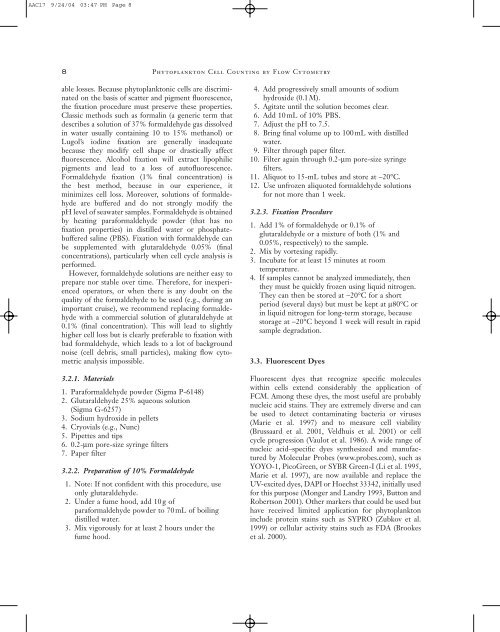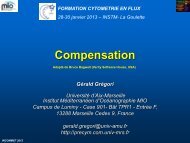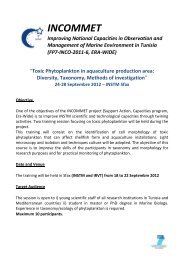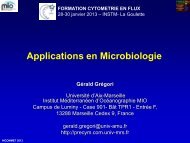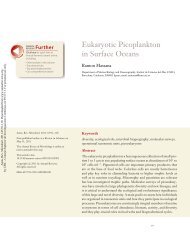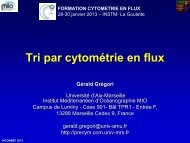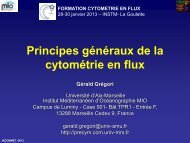Phytoplankton Cell Counting by Flow Cytometry - incommet
Phytoplankton Cell Counting by Flow Cytometry - incommet
Phytoplankton Cell Counting by Flow Cytometry - incommet
Create successful ePaper yourself
Turn your PDF publications into a flip-book with our unique Google optimized e-Paper software.
AAC17 9/24/04 03:47 PM Page 88 <strong>Phytoplankton</strong> <strong>Cell</strong> <strong>Counting</strong> <strong>by</strong> <strong>Flow</strong> <strong>Cytometry</strong>able losses. Because phytoplanktonic cells are discriminatedon the basis of scatter and pigment fluorescence,the fixation procedure must preserve these properties.Classic methods such as formalin (a generic term thatdescribes a solution of 37% formaldehyde gas dissolvedin water usually containing 10 to 15% methanol) orLugol’s iodine fixation are generally inadequatebecause they modify cell shape or drastically affectfluorescence. Alcohol fixation will extract lipophilicpigments and lead to a loss of autofluorescence.Formaldehyde fixation (1% final concentration) isthe best method, because in our experience, itminimizes cell loss. Moreover, solutions of formaldehydeare buffered and do not strongly modify thepH level of seawater samples. Formaldehyde is obtained<strong>by</strong> heating paraformaldehyde powder (that has nofixation properties) in distilled water or phosphatebufferedsaline (PBS). Fixation with formaldehyde canbe supplemented with glutaraldehyde 0.05% (finalconcentrations), particularly when cell cycle analysis isperformed.However, formaldehyde solutions are neither easy toprepare nor stable over time. Therefore, for inexperiencedoperators, or when there is any doubt on thequality of the formaldehyde to be used (e.g., during animportant cruise), we recommend replacing formaldehydewith a commercial solution of glutaraldehyde at0.1% (final concentration). This will lead to slightlyhigher cell loss but is clearly preferable to fixation withbad formaldehyde, which leads to a lot of backgroundnoise (cell debris, small particles), making flow cytometricanalysis impossible.3.2.1. Materials1. Paraformaldehyde powder (Sigma P-6148)2. Glutaraldehyde 25% aqueous solution(Sigma G-6257)3. Sodium hydroxide in pellets4. Cryovials (e.g., Nunc)5. Pipettes and tips6. 0.2-mm pore-size syringe filters7. Paper filter3.2.2. Preparation of 10% Formaldehyde1. Note: If not confident with this procedure, useonly glutaraldehyde.2. Under a fume hood, add 10 g ofparaformaldehyde powder to 70 mL of boilingdistilled water.3. Mix vigorously for at least 2 hours under thefume hood.4. Add progressively small amounts of sodiumhydroxide (0.1 M).5. Agitate until the solution becomes clear.6. Add 10 mL of 10% PBS.7. Adjust the pH to 7.5.8. Bring final volume up to 100 mL with distilledwater.9. Filter through paper filter.10. Filter again through 0.2-mm pore-size syringefilters.11. Aliquot to 15-mL tubes and store at -20°C.12. Use unfrozen aliquoted formaldehyde solutionsfor not more than 1 week.3.2.3. Fixation Procedure1. Add 1% of formaldehyde or 0.1% ofglutaraldehyde or a mixture of both (1% and0.05%, respectively) to the sample.2. Mix <strong>by</strong> vortexing rapidly.3. Incubate for at least 15 minutes at roomtemperature.4. If samples cannot be analyzed immediately, thenthey must be quickly frozen using liquid nitrogen.They can then be stored at -20°C for a shortperiod (several days) but must be kept at m80°C orin liquid nitrogen for long-term storage, becausestorage at -20°C beyond 1 week will result in rapidsample degradation.3.3. Fluorescent DyesFluorescent dyes that recognize specific moleculeswithin cells extend considerably the application ofFCM. Among these dyes, the most useful are probablynucleic acid stains. They are extremely diverse and canbe used to detect contaminating bacteria or viruses(Marie et al. 1997) and to measure cell viability(Brussaard et al. 2001, Veldhuis et al. 2001) or cellcycle progression (Vaulot et al. 1986). A wide range ofnucleic acid–specific dyes synthesized and manufactured<strong>by</strong> Molecular Probes (www.probes.com), such asYOYO-1, PicoGreen, or SYBR Green-I (Li et al. 1995,Marie et al. 1997), are now available and replace theUV-excited dyes, DAPI or Hoechst 33342, initially usedfor this purpose (Monger and Landry 1993, Button andRobertson 2001). Other markers that could be used buthave received limited application for phytoplanktoninclude protein stains such as SYPRO (Zubkov et al.1999) or cellular activity stains such as FDA (Brookeset al. 2000).


